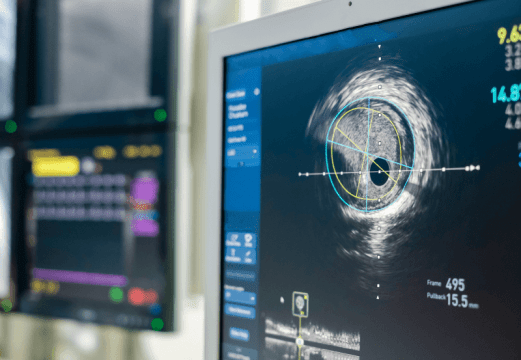The use of intravascular ultrasound (IVUS) to guide percutaneous coronary interventions (PCI) has been shown to reduce the risk of major adverse cardiovascular events (MACE) across controlled randomized studies, registries and meta-analysis. Current guidelines recommend the use of IVUS in left main disease and complex lesions.

As the prevalence of complex PCI increases over time, together with operator experience, several studies have shown that high volume centers or centers with experienced operators are associated with a remarkable reduction in future MACE risk, unlike low volume centers or those with less experienced operators.
The aim of this retrospective, observational study was to assess the link between operator experience and lesion complexity, as well as the correlation between operator experience and long term clinical outcomes. In addition, we looked into the interaction between operator experience and the effects of the use of IVUS in long term clinical outcomes.
Primary end point was the combination of cardiovascular mortality or target vessel myocardial infarction (TVMI) at 10 years. Secondary end point included cardiac mortality rate, AMI, TVMI, definite or probable stent thrombosis and ischemia driven target lesion revascularization (TLR) at 10 years.
In patients with complex heart disease, 63.4% underwent PCI by experienced operators, while 36.6% were treated by less experienced operators.
More experienced operators used IVUS more frequently for complex lesions, and presented a higher annual volume of PCI vs. their less experienced counterparts. Also, experienced operators exhibited higher SYNTAX scores, higher number of lesions, longer lesions, and more left main compromise. Patients undergoing IVUS guided PCI tended to be younger and present fewer cardiovascular risk factors, as well as fewer prior AMI and stroke.
Read also: bRight: Impact and Safety of the TriClip Device in a Real-World Cohort.
As regards outcomes, experienced operators showed lower risk of cardiac mortality or TVMI vs. less experienced ones. (HR: 0.779; CI 95%: 0.663-0.915; P = 0.002). The use of IVUS was significantly associated with reduced risk of cardiac mortality and TVMI vs. the group submitted to angiography guided PCI, both for less experienced operators (23.5% vs 11.4%; HR: 0.477; CI 95%: 0.337-0.673; P < 0.001) and the more experienced ones (18.0% vs 13.5%; HR: 0.747; CI 95%: 0.559-0.998; P = 0.048). There was a significant interaction between the use of IVUS and operator expertise when it came to cardiac mortality or TVMI risk (P = 0.037).
Conclusion
In conclusion, among patients with complex coronary PCI, IVUS guided PCI was associated with better outcomes at long term vs. angiography guided PCI, regardless operator experience. In addition, the beneficial effects of IVUS were remarkable when complex PCI was guided by less experience operators.

Dr. Andrés Rodríguez.
Member of the Editorial Board of SOLACI.org.
Original Title: Prognostic Impact of Operator Experience and IVUS Guidance on Long-Term Clinical Outcomes After Complex PCI.
Reference: Ki Hong Choi, MD, PHD et al J Am Coll Cardiol Intv 2023;16:1746–1758.
Subscreva-se a nossa newsletter semanal
Receba resumos com os últimos artigos científicos





